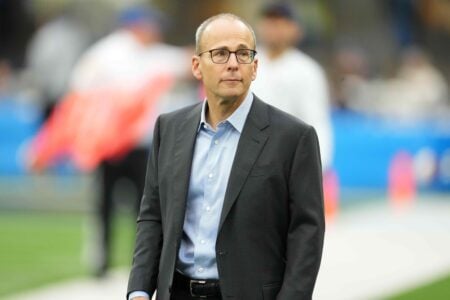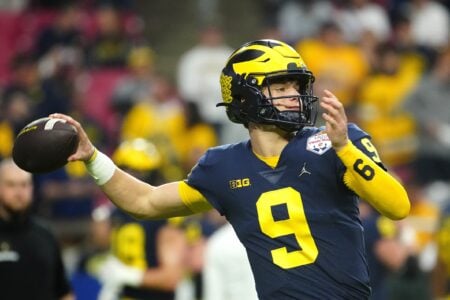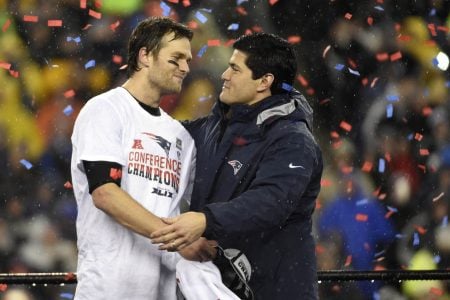- Joined
- Aug 3, 2009
- Messages
- 5,744
- Reaction score
- 5,306
Danger Zone covered it really well. And the methodology is a bit weird.
It would have been interesting to see expected AV vs. actual AV. So the Patriots drafting at 28 vs. the Colts drafting at 24, if they are equal in the draft, the Patriots, would still finish lower in the current system because they pick lower. But if it was expected value, then you could see who is exceeding it. That's why Jacksonville rates so high, they always have a top-10 pick. Of course if you just add up the AV of all the players and a team picks 20 spots higher than you year after year, they're going to score pretty well by this measure.
A few other notes: based on the methodology, I wonder if the Giants and Chargers got 0 value out of their 1st round picks in 2004 (Manning, Rivers) since they were both drafted first, then traded after. Therefore no value for their original drafting teams based on the methodology explained.
And then it doesn't factor in players for draft picks or vice versa. For example, the Patriots 4th-round pick for Randy Moss deal was huge. That draft pick (110) is worth 4.7 AV average based on Chase Stuart's draft chart. Moss's time in New England was worth 46 AV, plus a third round pick worth 7.4 AV (which was wasted on Mallett who had 0 AV in NE, so you could count it as nothing eventually or 7.4 at the time). Either way, almost 10 to 11 times more than the expected value of that pick.
Meanwhile, the Raiders got 0 AV out of that pick with John Bowie. But even if they got 1 AV, they would have "won" that trade based on this metric because they would have gotten credited for that draft selection and whatever AV came with it, while we get 0 because we traded the pick for a player.
If the Colts or Packers have drafted more players, so be it. And if they get more out of it, so be it. As I've said before and I'll say again, you play to win the game. I'd rather win a championship than win draft night. Part of why many teams have draft picks with lots of AV is because they have no choice. If they have an immature receiver they can't trust, they play him because they have to. If we have a guy who Brady doesn't trust, he doesn't play. The bad receiver gets catches and stats on his bad team and everyone wonders why we can't draft a guy like that. He gets handed the spot, given multiple chances to fail, and may or may not eventually develop.
I'm looking at you Darrius Heyward-Bey. He started 11 games as a rookie and caught 9 passes in 40 targets. The next year, he starts 14 games and catches 26 passes in 65 targets. He finally broke out a bit in his 3rd year, almost hitting 1,000 yards, before struggling in his last season in Oakland. Then he catches on with the Colts and doesn't produce much. But you can't coach speed, so he gets a few more seasons in Pittsburgh.
We cut Brandon LaFell because he only produced 37 catches in 74 targets in 9 starts for 515 yards after battling an injury all off-season. Heyward-Bey has exceeded that twice in 7 seasons despite only missing 7 games in his 7 seasons. The Raiders will get credit for 17 AV for Heyward-Bey, while we get 1 AV for Taylor Price because he wasn't good enough to start and didn't deserve it.
So I have a lot of issues with this study. I wouldn't put much into it.
It would have been interesting to see expected AV vs. actual AV. So the Patriots drafting at 28 vs. the Colts drafting at 24, if they are equal in the draft, the Patriots, would still finish lower in the current system because they pick lower. But if it was expected value, then you could see who is exceeding it. That's why Jacksonville rates so high, they always have a top-10 pick. Of course if you just add up the AV of all the players and a team picks 20 spots higher than you year after year, they're going to score pretty well by this measure.
A few other notes: based on the methodology, I wonder if the Giants and Chargers got 0 value out of their 1st round picks in 2004 (Manning, Rivers) since they were both drafted first, then traded after. Therefore no value for their original drafting teams based on the methodology explained.
And then it doesn't factor in players for draft picks or vice versa. For example, the Patriots 4th-round pick for Randy Moss deal was huge. That draft pick (110) is worth 4.7 AV average based on Chase Stuart's draft chart. Moss's time in New England was worth 46 AV, plus a third round pick worth 7.4 AV (which was wasted on Mallett who had 0 AV in NE, so you could count it as nothing eventually or 7.4 at the time). Either way, almost 10 to 11 times more than the expected value of that pick.
Meanwhile, the Raiders got 0 AV out of that pick with John Bowie. But even if they got 1 AV, they would have "won" that trade based on this metric because they would have gotten credited for that draft selection and whatever AV came with it, while we get 0 because we traded the pick for a player.
If the Colts or Packers have drafted more players, so be it. And if they get more out of it, so be it. As I've said before and I'll say again, you play to win the game. I'd rather win a championship than win draft night. Part of why many teams have draft picks with lots of AV is because they have no choice. If they have an immature receiver they can't trust, they play him because they have to. If we have a guy who Brady doesn't trust, he doesn't play. The bad receiver gets catches and stats on his bad team and everyone wonders why we can't draft a guy like that. He gets handed the spot, given multiple chances to fail, and may or may not eventually develop.
I'm looking at you Darrius Heyward-Bey. He started 11 games as a rookie and caught 9 passes in 40 targets. The next year, he starts 14 games and catches 26 passes in 65 targets. He finally broke out a bit in his 3rd year, almost hitting 1,000 yards, before struggling in his last season in Oakland. Then he catches on with the Colts and doesn't produce much. But you can't coach speed, so he gets a few more seasons in Pittsburgh.
We cut Brandon LaFell because he only produced 37 catches in 74 targets in 9 starts for 515 yards after battling an injury all off-season. Heyward-Bey has exceeded that twice in 7 seasons despite only missing 7 games in his 7 seasons. The Raiders will get credit for 17 AV for Heyward-Bey, while we get 1 AV for Taylor Price because he wasn't good enough to start and didn't deserve it.
So I have a lot of issues with this study. I wouldn't put much into it.

















